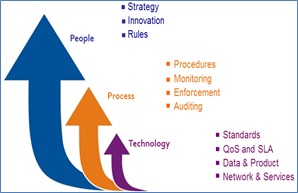Every top level business leaders agrees that the cost of doing business operations includes IT operations and supports. Although the enterprise business cannot run without IT functions, IT operations has always been looked at as cost & expenses rather than being viewed as an opportunity to grow the business exponentially. Today’s business world, Many enterprises have started adopting “IT as a Service” (ITaaS) model for better operational efficiency, cost balancing, measure the ROI and quicker process alignments. This is wise considering the usefulness of business decisions to ramp up the heavily-used requests and ramp down the trivial ones.
The enterprises are also adapting many functions as ‘as a service’ models that include payment processing, call centre, Cloud / SaaS, Infrastructure as Services. ‘As a service’ model might sound counter-intuitive, but there are few concrete advantages as listed below:
- Improved financial transparency of IT for management.
- Competitive business model for better Governance, Strategy and Efficiency.
- Better Business Vs IT alignments compare to other models.
- Optimized mix of capital and operating expenses.
- Agility to match business priorities.
- Measurable RoI against initiatives.
- Lower investment and operations cost.
The SOA aspect:
In the technical world, there is an interesting aspect in SOA (Service Oriented Architecture) that they can be provided ‘As a Service’ model, since SOA is fundamentally a consolidation of services and processes. These can range from simple data related services to enterprise applications and processes as services. The specific interest is to offer these services to the departments within the enterprises and the external sources to leverage these services as ‘Pay as you go’. The power of this model is by leveraging in-house to multi-tenant services across enterprise units and by extending to external world that multiplies the SOA utilization exponentially and in turn can bring much needed business revenue.
The best example would be Google’s ‘Search Service’ which is being offered to external world as a service for different purposes. This ranges from retrieving data on weather, stock quotes, sport scores, unit conversion, currency conversion, calculator, maps, location services, package tracking, etc which brings more meaning to Google’s business than it is from its search page.
Innovation and creativity is the key to expand business when we offer such services to internal and external service consumers. Based on the trend analysis, the needs of these services can be identified and improvised based on the consumer market such as offering additional features for additional cost based on the specific business needs. For example, offering paid service with load-balanced servers to reduce the response-time with SLA, providing additional volume of data for data services, etc.
The Role of SOA in “Business – IT Alignment”:
Organizations are always struggling to align its business expectations with IT outcomes. Unlike times a decade ago, the business wants to drive with more and more agility. This requires changes to be effective with less timeframe. However, this vision could not be achieved if the IT does not run with SOA principles. For example, if the business introduces a new idea to be taken to the market based on the consumer trend, it would often become obsolete if it incurs lot of delay. This is because, the trend is likely to find its own course when the new business ideas are in place.
Creating the new services from scratch to replace the operational applications is often unrealistic given the time required to procure environments, setup new software and the implementation of the legacy logics. The practical approach to SOA evolution would be to efficiently involve middleware platform and intelligent front-end applications integrated with web-services using SOA governance and best practices.
The above diagram illustrates the advantages of introducing SOA where IT is loosely coupled with business, thus bringing agility in IT platform. This ensures that the changes in IT platform are seamless and agile to bring numerous business potentials leveraging all the existing legacy systems integrated effectively with the business.
Technically, the business can be involved along with I.T. in the early stages of new business strategy when following Service Oriented Architecture. The reason is that the modern technologies uses platform-agnostic technology standards such as XML and interoperability using WSDL based SOAP services. The format of these XMLs and WSDLs can be visualized well by business experts (without SOA technical skills) driving the very objective of the business.
The need of SOA Governance:
All the technology advancements have to be made with the great care. The enterprises, when adopting SOA, can be quickly overwhelmed by its growing number of SOA services, if not managed properly. SOA Governance is a set of processes, tools, organizational structure, design and architecture principles that allow the enterprise to bring People, Processes and Technologies aligned together to bring SOA promise with the below features:
- Design to build repeatable business processes with layered approach (Loosely Coupled Architecture).
- Design to compose business processes out of autonomous business services (Federation).
- Enforcing open standards using XML, JSON over HTTP. (Interoperability).
- Reusable components with TDD (Test Driven Development).
- Enables efficient Business Event Management (Monitoring).
With SOA being implemented by several enterprise organizations now, I believe that SOA based IT services would help to establish per mature ‘IT as a Service’ model and leverage the services capabilities provided. The additional technology solutions such as Business Activity Monitoring and Optimization will help to measure the performance of business operations and generate opportunity to align the business.
Note: The above article is authored by Mr.Siva Thankamanee from Enterprise Integration Team @ Aspire Systems.
- Why retail brands are gunning for iPaaS-led omnichannel integration - January 7, 2020
- 5 New Year Resolutions to Accelerate Digital Transformation with Dell Boomi in 2020 - December 30, 2019
- How iPaaS drives seamless order fulfillment journeys - December 18, 2019








Comments